Introduction
I am happy to be back talking about executive function today. There is so much more information that I have to share. This topic is based on the last five years of research and some product appraisals of some articles that I found that may be really helpful. The most important thing that I want to say is that we have to have a mindset shift when we are working with kids with any behavior or executive function issues, especially in those with autism spectrum disorder (ASD). Every child wants to succeed and nobody wants to fail. This is one of my favorite quotes by Annette Breaux. "Remember, everyone in the classroom has a story that leads to misbehavior or defiance. Nine times out of 10, the story behind the misbehavior won't make you angry. It will break your heart." I was reminded of this quote yesterday as I was volunteering in a school. We had a lot of kids from the foster care system. These kids lacked attention and not many had IEPs or 504 plans. They really just wanted our attention and were not misbehaving out of willfulness. It was important for me to refresh my brain and shift my mindset.
Today, we are going to talk about executive function and define it. We are going to talk about how it is important to the occupation of children with autism. The second thing we are going to do is summarize the meaning of the Theory of Mind and its effects on daily living tasks. I was not aware of the impact of Theory of Mind on executive function until I did the research over the last two years. And, if we do not consider this critical component, we are missing the boat on executive function. We are also going to be able to list at least five interventions for building executive function skills. These are all going to be based on the Occupational Therapy Practice Framework, 3rd Edition. For those of you who are not familiar with this document, you probably should print it out and put it on your desk. I refer to it quite often because it is the critical way that we should document and look at our clients based on the most recent research and evidence that is out there.
In my interoception book, I created the character, Bright Brain (see Figure 1).
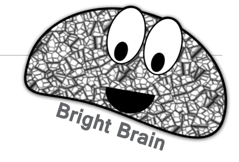
Figure 1. Bright brain.
I created characters to help students learn about their body. I wanted the characters to be happy and cheery so that they could visualize the brain without making it too anatomically correct. When you are helping your students you can say, "Bright brain is on now." There are some free downloads on my website.
A Little Bit About Me
- Mother to two children with autism
- Faculty at the University of Saint Augustine MOT and OTD programs
- Advisor for OT and contributing author for Autism Asperger’s Digest Magazine and Autism Parent Magazine
- Speaker across the US for Universities, Future Horizons Autism
- Conferences, state and local organizations
- Co-Founder of Aspire Pediatric Therapy, Founder of Route2Greatness, LLC, & Owner of The Pocket Occupational Therapist, and OT2OT Program
- Executive Vice President of Content for www.myHana.org
I have two children with autism spectrum disorders, ages 17 and 19 years old. I have gone through quite a bit of therapy on a personal level to help my children with occupational therapy and ABA therapy. I also work with the special needs community, I hope I can give you perspectives from being a mom and a therapist.
I am also a new faculty member at the University of St. Augustine. I am so happy to be here. I also help with the Autism Asperger Digest magazine as the OT advisor, and I write articles. In this magazine, we talk a lot about autism and sensory and executive function. It is my volunteer work, and I do not make any money for this.
I talk all over the country about autism. I speak with Temple Grandin, Carol Kranowitz, and some others. We are out there trying to help families and therapists to do their best work with these kids. We also have a website called "myHana.org." That website is something that we are developing as a service to families of kids with autism.
Finally, I am known as the Pocket Occupational Therapist. My website is www.pocketOT.com. Again, I like to give free resources to caregivers, families, and therapists. It is important for me to share my knowledge freely. My books are shown in Figure 2. I have them written in layman's terms for new clinicians or clinicians new to school practice. These are also helpful to families because educating families as so much of what we do is carried over into the home.

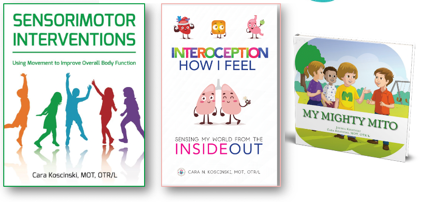
Figure 2. Resources from Cara.
My children were on the "Autism Asperger Digest" cover, on the top right (see Figure 3).
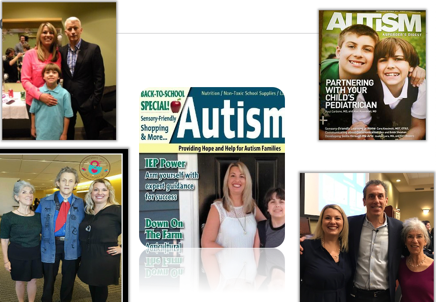
Figure 3. More info about Cara.
That is what they looked like a few years ago.
EF and Autism Overview
First, I want to give an overview of executive function which is going to be abbreviated EF and autism which is Autism Spectrum Disorder or ASD.
Autism Spectrum Disorders (ASD)
- 1 out of every 59 children in the United States has autism
- Autism undermines cognitive, social, emotional, and occupational capabilities
- Insistence on routines and decreased ability to think outside of the box to develop creative ways to solve problems
(CDC, 2018)
As the most recent statistics show, one out of every 59 children in the United States has some form of autism. Why I want to hone in on executive function in autism is because there is a really good chance that you are going to be working with someone that has autism due to these prevalence numbers. We are going to come across these kids whether they are diagnosed or not.
The biggest impacts are found in cognitive, social, emotional, and occupational capability areas. About 50% of kids with autism are verbal and the other half are not able to verbalize. But, of those that are verbal, it is very difficult for these kids to express themselves. By definition, autism affects a child's ability to communicate reciprocally in a conversation. Many may fixate on routines, and it is hard for them to think outside of the box. Everything is always the same way. Thus, it is hard for these kids to solve problems. In life, we often have to creatively problem solve as nothing is black and white, and that is really hard for these kids to understand.
ASD and Play
- Repetitive patterns of behavior, difficulties with transitions between activities, (APA, 2013)
- A hallmark issue for children with ASD includes deficits in pretend and symbolic play skills (APA, 2013)
- Occupational therapy for children is rooted in the foundation that play is the method of skill acquisition (AOTA, 2014)
- Play skills and EF deficits are linked and both contribute to delays in occupational performance (Berenguer et al., 2018)
What does ASD have to do with play skills? This is specific to occupational therapy. Repetitive patterns of behavior cause difficulties with transitions and other issues. If you think about a child with autism, they may only play with cars, trains, or whatever is their particular interest, And, they are going to play with that item in a repetitive way. They are not going to use creative play that we see in typical kids. They are not going to explore and have an imaginative creative play. This is going to affect them as they develop and have to function in real life.
Transitions are also hard also. This is moving from activity to activity or stopping something that is preferred to do something that is not preferred or something that must get done. That is tough on these kids. The other thing is that pretend and symbolic play are limited. Typically, developing kids make up stories and use their imagination.
EF Overview
- Important to know both order in which skills emerge AND what each skill ‘does.’
- Begin after birth and continue to adulthood.
- Frontal and Pre-frontal cortex
- Two ‘types’ of skills
- Thinking (cognition)
- Doing (behavior)
(Berenguer et al., 2018; Sun et al., 2017)
Play is how we learn skills. You can see how these kids might be at a disadvantage. They are not learning the skills that are critical for developing creative play and have a lot of difficulty with occupational performance. This is going to affect their executive function. Executive function is something that develops over time with practice and experience.
Executive functioning occurs in the frontal and prefrontal cortexes, and we will talk about that a little later. Even though these do not develop until the age of 25, we need to know in which order the skills come in and what they do. Many people say, "What difference does it make if it doesn't mature until adulthood?" This is something we need to keep in mind as kids play and learn. There are connections made in the brain as kids play and develop. We need to know the typical milestones in order to see what a child may be lacking.
There are two types of skills. There are thinking skills, which we know as cognition, and doing skills, which are behavioral.
EF Definition/Components in Current Literature
- Demetriou et al. (2017) completed a Level I study that determined planning, concept formation, planning, mental flexibility, fluency, and response inhibition
- Josman and Meyer (2019) completed a scoping review of fifty articles that found over thirty constructs in OT literature for defining EF
- Cramm et al. (2016) determined OTs did not recognize the widespread effects of EF on the occupational performance of children with ASD
As I did this literature review for my capstone project, I found it interesting that there is not really one definition of executive function. I think this why occupational therapists struggle with our scope of practice in this area. If you look at the second article by Josman and Meyer (2019), they reviewed 50 articles and found that there are over 30 constructs for defining executive function in the OT literature alone. That can be confusing because in the DSM there is only one definition of autism or one definition of depression. We have concrete definitions for other disorders, but executive function comes as a comorbid condition and there is not a definitive definition. According to Demetriou et al., planning, concept formation, mental flexibility, fluency, and response inhibition are very common characteristics of EF.
Many OTs may not recognize that executive function has a critical impact on the performance of our kids. I think we oftentimes leave this to the speech pathologists and this causes problems. We discharge our kids when they meet the fine motor goals, can cross midline, or an appropriate grasp on the pencil. But, if we never touch executive function, then our kids are not prepared for critical things in life such as writing checks, grocery shopping, preparing for a job, and functioning on the job. We really see a lack of skills in our kids globally.
Many people compare air traffic control to the executive function system.

Figure 4. Air traffic control center.
In the air traffic control center, they have to manage many tasks at the same time, but there are many people working together. In our brain, it is just us. Think of these guys and females in the air traffic control center as our neurons. These people are making connections and figuring it out. To keep using this metaphor, what happens if an airplane comes in late or if it does not land properly. There has to be some flexibility. Similarly, a child cannot just line up cars and trucks, spin wheels, or engage in their intense interest all day long. They have to be flexible and stop those things in order to do self-care or school tasks. There are a lot of components that are moving in many different directions in order for smooth executive function. We have to manage tasks every day, and this is the set of skills that we utilize. I could also use this course as an example. You had to stop something else in order to watch this course. Difficulties often arise when we want kids to transition between tasks. This is also an executive function task.
What is EF?
- Set of skills to manage tasks we complete every day
- What we will pay attention to and what we choose to do
- Manage emotions and thoughts so we can be efficient
- Regulate behavior when difficulties arise
- Assist in the ability to function independently
Obviously, executive functioning also helps them with independence as we have to be efficient in life and use our energy and resources wisely.
Two Types of Skills
As I stated earlier, there are two types of skills, thinking and doing (see Figure 5).
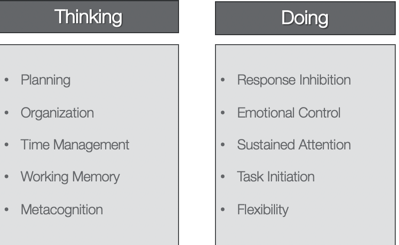
Figure 5. Examples of thinking and doing. (Cramm et al., 2016; Demetriou, 2016; Josman & Meyer, 2019)
The thinking category includes the typical things we think about with executive function. It is the making of the plan, the organizing of yourself, and the materials necessary for the plan. It is also the managing of time. This is looking at the appropriate amount of time and working accordingly. For example, I have to present an hour-long course. I cannot rush through the course and have half an hour left. I have to manage that time. This is an abstract concept. The concept of time is very difficult for some of our students that lack the knowledge of abstract concepts. We have to teach them these skills. Do you see how, even though executive function matures at age 25 years in young adulthood, we have to build these little components throughout the journey of childhood through play to help these individuals become functioning adults? Another component of this is metacognition. The whole point of metacognition is that we can step outside of ourselves and evaluate our own performance. Metacognition is how are we doing and performing and what changes we need to make.
Then, there are doing skills. Response inhibition is to stop those behaviors. We need to control our emotions and attend for a prolonged period. Let me tell you a very quick story about task initiation. I was working with some young teenagers, probably between the ages of 10 and 13, on a task. I said to them, "We're going to move the furniture in this room. How would you plan this?" I was trying to move things around in a resource room to make it more user-friendly. They really had no idea where to start or even how to begin moving things around so they just decided that they were not going to start the task at all. Many times, we call our kids lazy, but the honest truth may be that they do not know how to start a task as it seems so overwhelming. Flexibility is also very hard.
EF Neurology
How Brain Connections Are Formed
At a child's birth, we know that there are not a lot of connections between the neurons. View this link. If you look at the left side there you can see that at birth, the neurons are not connected. They look like spaghetti. Look what happens at seven years of age. There are a lot of connections here. This brain is super connected; however, at 15 years of age, the brain says, "Hey, I need to be efficient." The principle of "use it or lose it" occurs, and the brain only maintains the connections that it is using for efficiency. Working on executive function helps to prune and strengthen connections.
Regulation
- Behavioral inhibition
- Delay response vs. immediate gratification
- Stop behaviors when they are not working
- Manage distractions that could interfere
(Cramm et al., 2016; Demetriou, 2016; Josman & Meyer, 2019)
I teach a lot of courses on behavior, and it is so important to understand regulation. We need to delay our responses versus providing immediate gratification. There is a big difference in gratification between a two-year-old and a 10-year-old. A two-year-old has no ability to delay that response or wait for that gratification. There is no patience there but that should come through maturity. And, if the behavior that we are displaying is not working, we need to be able to stop that behavior and do something else. However, this can be very hard. They also need to learn to manage distractions that can interfere, and we are counting on these kids to automatically do that. These are some aspects of regulation.
- Our ‘optimal’ state of learning
- We are engaged and ‘in tune to’ our environment
- Not ‘too’ energetic and not ‘too’ tired.
- Just right state of BEING
(Jahromi, Bryce, & Swanson, 2013; Josman & Meyer, 2019)
Regulation is also our optimal state of learning. Throughout the day, you are not going to be in the same state. You wake up in the morning, and you are in a different state than when you go to bed. That means that we are tuning into our environment as our environment constantly changes throughout the day. We cannot be too energetic or too tired, but rather we must be just right. This can be a complicated thing.
What is just right? How do we find the right challenge? Sensory processing comes into play, but we also need regulation of our bodies. There is an optimal range of arousal. Throughout the day, we should be somewhere in this optimal range. Kim Barthel has done some great work in this area. Depending on what happens to us, we should be a little bit more alert sometimes and a little bit less alert othertimes all while staying in this optimal zone. Here is an example of what I mean. In the morning when you drive to work, you may find that your rearview and side mirrors and your seat are too low. You may need to adjust them up a little bit. Your body is more alert and you are ready to go. In contrast, by the end of the day, you may be slouching more and need to adjust your seating and mirrors lower again to accommodate that. You cannot maintain the same level of alertness all day or you would be exhausted. This is going to play into our interoception piece as we go forward here. It is really important to teach kids how to self-regulate and know how they are feeling. The Alert Program is great for teaching regulation.
Upstairs Vs. Downstairs Brain
- Tantrum:
- Conscious choice
- Strategic and manipulative
- Can reason, make choices
- Emotions under conscious control
- STOP when demands are met
- Sensory:
- Flood of hormones
- Over-ride conscious choice
- Loss of body control
- Can NOT be reasoned with
- Not capable of choices
(Siegel & Payne Bryson, 2011)
Next, I want to talk about the upstairs versus downstairs brain. Dr. Daniel Siegel and Tina Payne Bryson wrote the book, "The Whole-Brain Child." The downstairs brain is the brain stem. The brain stem is when you are using that downstairs brain. This is where our fight or flight responses are located as well as physiological things like breathing, maintenance of heart rate, memory, and things that keep us alive and in a regulated state. The downstairs brain is more automatic, and it is comprised of the hippocampus, the amygdala, and all those structures at the bottom of the brain.
The upstairs brain includes the cerebral cortex or the area for thinking, play, empathy, and body control.
When a child perceives danger, they are in the downstairs brain as they are using that fight or flight reaction. And, it is really hard to get out of that fight or flight response because it is chemically driven. Cortisol is released into your body for safety. But when we are using our upstairs brain, we are able to make conscious choices. This is where metacognition and all of the higher-level executive functioning takes place.
But of course, when we look at the connection between the lower and higher brain, we need to practice making those connections. When things happen in the environment or with our bodies, we need to use conscious choices instead of always going into fight or flight mode. This takes practice. When there is a true sensory meltdown, there is no conscious choice because the goal is safety. And, when someone is having a tantrum, they are in the upstairs brain because they can make choices and are looking for your response. A tantrum is a conscious choice. Again, executive function is the emotional awareness of yourself and your body.
Neuroscience's Star Patient
- Phineas Gage:
- Injured by explosion
- Changed personality
- Impulsive
- Poor decision making
(O'Driscoll & Leach, 1998)
Phineas Gage is one of neuroscience's star patients. He was a very nice man, and he had a family. He was laying railroad ties. During this process, they used explosives to clear the way. During one explosion, Phineas Gage got a piece of rebar stuck in his frontal lobe and his prefrontal cortex, and his executive function changed. He became impulsive, his personality was different, he started to make bad decisions, was sexually promiscuous, and became an alcoholic. This really had an impact on executive function. Look Phineas up. He is a very interesting case.
Frontal Lobe
- Rational thinking
- Future considerations
- Flexibility
- Matures at age 25
- Mindfulness: Manage the internal environment Interoception
- Manage Mood (to reduce intrusive thoughts)
- Manage fatigue (pacing, regular breaks)
- Manage physical comfort (pain, hunger, thirst)
(Henri-Bhargava, Stuss, & Freedman,2018)
What does the frontal lobe do? This is where our rational thinking is. Most kids are immature up until the age of their mid-20s. Many are impulsive, and it is very hard for them to think about the future considerations of their decisions. This is why they make so many mistakes. And, kids with special needs have a little bit slower development to consider. Interoception is something else that we need to work on. This is our ability to manage our mood, to think about our fatigue, and think about our physical comfort. We need to start early to help these kids. "What about taking breaks?" "Knowing when you're really tired is important." We know our kids are pushed and pushed with complicated tasks in school. They are probably exhausted by the end of the day, and that is why they have these meltdowns. This is critical to remember.
Metacognitive Process
- Internal awareness
- How am I progressing
- Am I on track to meet the deadline
- Self-reflection
- External awareness
- Am I on track with others
- See how they are doing it
(Jahromi, Bryce, & Swanson, 2013; Josman & Meyer, 2019)
The term metacognition warrants some extra explanation because it is complicated. It is like looking down from the ceiling at yourself. We want to teach our students to say, "How am I progressing? Am I on track?" You want to teach them to reflect on tasks after they are finished.
When you are trying a new task, you look to your peers. However, a child with autism is not really good at social engagement, and they might not reference their peers. We might have to teach them how to check in with peers. Are they on track to meet their deadline? You can start by using a rubric. Even if you are setting up a simple handwriting or fine motor task, you can have them process at the end for a few minutes. You want them to reflect on how they did. "I made a lot of mistakes." Start working through the processing part with these students at the end of each session.
The other thing to remember is that we learn from our mistakes. Many kids with autism get upset when they are not perfect, but we need to teach them that we learn by making mistakes.
SILK
Here is a little game. I am going to say the word silk three times, and I want you to repeat it after me each time. Silk. Silk. Silk. What do cows drink? I am guessing that most of you said milk because of silk and milk rhyming. And, if you said water, good for you because that is the right answer. You can share this with your kids. It is ok to make a mistake and learn from it.
Subcortical Level
- Intense emotions
- Impulse reactions
- Rigidity
- Lack of self-reflection
(Berenguer et al., 2018; Jahromi, Bryce, & Swanson, 2013)
On a subcortical level, kids with autism can have intense emotions, impulse reactions, and rigidity. They try to control their environment to make it more comfortable. They also have a lack of self-reflection.
Theory of Mind (ToM)
Definition
- Theory of mind (ToM)—the specific ability to attribute mental states to oneself and to others
- Manage the external environment
- Reduce distractions (auditory, visual)
- Allocate sufficient time for tasks so less time pressure to distract
- Structure and routine
(Berenguer et al., 2018; Chan et al., 2016; Jones et al., 2018)
Theory of Mind is the ability to attribute mental states to yourself and to others. Let's say I am invited to a party. I walk into the party and assess people. I want to see where the people are that I like. What are they doing? Is someone crying in the corner? Is someone laughing? Is there a fight that has broken out? I am reading the room so to speak. This is the Theory of Mind in action. It really helps us then to manage our external environment/ We have to have some structure and routine to make the environment successful.
ToM and EF
- A child’s ToM is significantly associated with the ability to engage in pretend play.
- ToM include deficits in initiating play activities, object substitutions, and making inferences (Chan et al., 2016).
- Decreased ability to communicate and difficulty putting yourself in someone else’s shoes adds to struggles with EF (Jones et al., 2018).
- ToM relates to EF since it helps in social settings by limiting conflicting behaviors during interpersonal interactions.
- It also includes intuitive social skills, understanding sarcasm, visual perspective-taking, and social-emotional reciprocity (Jones et al., 2018).
We know by the research that Theory of Mind deficits are associated directly with the ability to engage in pretend play. If a child with autism cannot engage in pretend play, it is assumed that they are going to have some theory of mind deficits. These kids have problems initiating activities and substituting an object for another. They have trouble putting themselves in someone else's shoes.
This is also difficult in social settings. If you are not able to read the room appropriately, you may start talking loudly about Minecraft for an hour when everyone else is quiet. That is inappropriate, but you may not be able to see that. They have trouble with sarcasm, visual perspective-taking, and social-emotional reciprocity. This also affects their ability to perform functional tasks. Hopefully, this is all starting to fit together.
OTPF, 3rd Edition as Foundation for Evidence-based Practice
Evidence-based Assessment Ideas
- Utilize the ToMI-2 Assessment (Hutchins, Prelock, & Bonazinga, 2012)
- Use the BRIEF Assessment (Josman & Meyer, 2019)
- Complete an activity analysis during structured clinical observations of adaptive behavior, social skills, regulation, caregiver-child interaction (AOTA, 2014; Gentles, Nicholas, Jack, McKibbon, & Szatmari, 2019)
- Complete occupational profiles with caregivers to understand the child’s occupations at home and when considering challenging behaviors (AOTA, 2014; Gentles et al., 2019)
We can refer to the Occupational Therapy Practice Framework (OTPF), 3rd Edition, as a way to learn more about evidence-based assessment ideas. The ToMI-2, the Theory of Mind Inventory Two assessment, is good for assessing Theory of Mind concepts we discussed earlier. I have been an occupational therapist for 22 plus years, and I have never looked at Theory of Mind. We are discharging clients when their fine motor and other needs are met, but we are not addressing this important concept which leads to later struggles in life.
The BRIEF assessment is one of the most common and effective tools to assess executive function. There is a great article about this by Josman and Meyer from 2019. One of my goals professionally is to create an executive function assessment. If you have any ideas, let me know. As our kids with autism start to age, we are seeing huge deficits in this area. It is important for kids to work on life skills out in the community.
There are other areas that can be addressed like an activity analysis of social skills and caregiver-child interaction. We really need to get back to basics and use the occupational profile as well. This is one of the most effective ways to get information about the child's occupation in-home and considers their behaviors, looking at the whole setting of the child.
Evidence-based Interventions
- Performance skills listed in Framework III in global and specific mental functions provide the structure for OTs to create adaptions and modifications.
- Utilize terminology from Framework III such as chooses, gathers, handles, inquires, sequences, notices, adjusts, and accommodates.
- Occupational therapists should gaze through an EF lens to view tasks commonly completed in OT sessions (Josman & Meyer, 2019).
- Build performance skills in lesser-known categories of the Framework III such as approaches, times response, regulates, heeds, accommodates, and expresses emotion.
AOTA (2014)
Performance skills listed in the Occupational Therapy Practice Framework, 3rd Edition, are global and specific mental functions. We need to create adaptations and modifications to help these children to succeed. Let's say you are using an obstacle course. During this task, the child trips and falls. You could say, "Well, you did really well on five of the things, but on two you tripped and fall. What do you think happened?" You are building in this self-assessment this right into your treatment. The same thing with the handwriting. I know in Bev Moskowitz's Size Matters Handwriting Program, she encourages the students to look at the letters they made and circle the ones that are good. This self-assessment is so critical.
We also need to use OTPF terminology. We need to think about choosing words such as gathers, handles, and inquires. The word inquires is indicating that they are asking questions. When we do not know something, we ask questions. Other words are sequences, notices (threats in the environment, notices their body, and notices their heart rate), adjusts, and accommodates. I bet if some of you either are not familiar with the OTPF or have not read it recently, you are probably thinking this is all speech pathology. However, it is in our scope of practice, and we need to be assessing these things.
While there is no formal assessment for everything, we can use activity analysis. For example, in order to assess handwriting, we can use an executive function lens instead of just looking through a fine motor lens. We need to really analyze the "why" behind what the issue is. There are a lot of lesser-known approaches. How do they approach the task? What is their attack method? What is their plan? How is their response? How do they time that? Again, regulation is not just sensory. It is the alertness and awareness. They also need to accommodate, heed, and express emotion. When we are working on planning with our kids, we could include them in the designing of the task. I am going to use the example of an obstacle course again. "How are we going to plan this course?" "If we are working on balance, what do you think we could do to work on planning skills?" This is engaging the student and giving them predetermined choices to build their confidence. It is so important to have both the child and the family involved.
AOTA Practice Guidelines- Individuals with Autism Spectrum Disorder
- Video Modeling
- Turn-taking games such as checkers, chess, Jenga
The AOTA has put together guidelines that are based on current evidence. One example is video modeling. This could be used to work on planning and Theory of Mind. For example, typical peers could do a video based on social skills. Or, if you are working on something else that is functional, like planning something, you could model it for them and videotape it. Then, they could watch it as many times as they needed. There are also many videos on YouTube.
Turn-taking games have also been proven to work and help these kids. This is because they have to stop that impulsivity and take turns.
Games
- Peek-a-boo
- Block copying
- Fingerplays
- Hokey Pokey
- Simon Says
- Use inhibition such as FREEZE….Ring around the Rosie
- Talking about mutually shared experiences
- Imaginary play
Games that typically developing kids have already done at younger ages, like Peek-a-Boo, can be adapted for older ages. Other activities like copying blocks and fingerplays, like "Where is thumbkin?" are also options. Kids that do not like to look at other people might have trouble with those games. We need to re-implement them in an age-appropriate way. Hokey Pokey and Simon Says are really good games. In Simon Says, they have to wait for the person that is calling to give the command. They cannot just do what they want. Freeze tag is great as it is a mutually shared experience. Imaginary play can be worked on through so many different things. We are creative as OTs, and we can help these students to work on imagination even as older kids.
Social and Theory of Mind Skills
- Consider the effects of EF dysfunction on social skills and pragmatic language, both of which increase the smooth performance of ADLs (Berenguer, Miranda, Colomer, Baixauli, & Rosello, 2018; Sun et al., 2017).
- Use riddles, Pictionary®, and Scrabble® to help improve performance skills and performance patterns in social interaction (AOTA, 2014; Chan et al., 2016).
- Target skills outlined Framework III such as approaches, times responses, regulates, heeds, accommodates, and expresses emotion (AOTA, 2014).
How do we build these? We need to think about pragmatic language. For example, an adult needs to go to the grocery store. In order to do so, they need to walk into that store and talk to someone if they need help. These are social skills where we need effective language, and we need to wait for our turn. We need to interact with others. Games like Pictionary and Scrabble can help practice these skills, and this is based on evidence. Again, we are working on specific skills such as approaches, times responses, regulates, heeds, accommodates, and expresses emotion. I encourage you to look through that framework.
EF Components
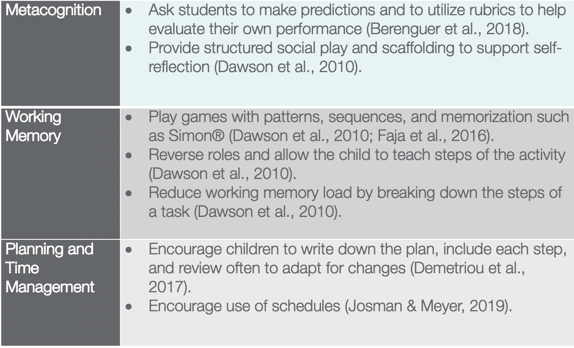
Figure 6. The different components of executive function.
How are we going to work on these little components? For metacognition, we can have them make predictions and utilize our rubric. I have created rubrics for pretty much everything, I've done in the clinic. As a professor in a college program, we utilize rubrics for our students. And, if you look at work evaluations for any kind of job, they evaluate your performance based on a certain rubric. Teaching students what that is, how to look at their performance, and see how they match up is critical. For working memory patterns, sequences and memorization games such as Simon, are really good for that and evidence-based. Another idea is reversing roles and allowing the child to teach you. Let the student play the therapist and have them teach you the steps of a task. That way they might understand the steps. Working memory is needed in so many tasks, not just retaining a phone number as an example. It might be remembering the main idea of a paragraph. Planning and time management are also very critical skills. Building things and planning schedules are good tasks. When you are working on schedules with your students, you should probably teach them how to use a pencil instead of a pen. Post-it notes can be helpful as everything changes in life, and they have to learn to roll with it.
Conclusion
- EF affects vast areas of occupation in children with autism.
- Play is greatly affected by both autism and EF dysfunction.
- ToM should be considered as a critical component of EF and IADL performance.
- OTs need to complete an occupational profile to determine areas ‘lesser-known’ when considering EF.
- OT clinicians should consider working with older children on EF skills.
Executive functioning has a huge effect on our students. Those individuals with autism have a lot of issues in this area. executive function. You need to look at developmental milestones when you are considering executive function because knowing what happens in what order is important. As in any scaffolding, if we miss a foundational skill, we cannot build upon it. We need to go back and reteach the skill that the child is missing.
We also know the play is greatly affected by the Theory of Mind and executive function components. As occupational therapists, we are already poised and ready to work on this. Using the occupational profile and considering those lesser-known areas is critical. We often discharge kids too early, and when the parent or the doctor sends them back to OT, we do not know what the heck to do with these kids. We need to work on life skills like setting up a grocery list, writing checks, creating study skills, and organizing a calendar. "Hey, let's write a bullet point list of the plan and take little steps to meet the goal."
Those are the main takeaways from today. I am really glad that you took the time to learn more about executive function.
References
American Occupational Therapy Association. (2014). Occupational therapy practice framework: Domain and process (3rd edition). American Journal of Occupational Therapy, 68, 1-48.
American Occupational Therapy Association. (2018). Vision 2025. American Journal of Occupational Therapy, 71,7103420010. https://doi.org/10.5014/ajot.2017.7130027103420010p1
American Psychiatric Association. (2013). Diagnostic and statistical manual of mental disorders (5th ed.). Arlington, VA: American Psychiatric Publishing.
Berenguer, C., Miranda, A., Colomer, C., Baixauli, I., & Rosello, B. (2018). Contribution of theory of mind, executive functioning, and pragmatics to socialization behaviors of children with high-functioning autism. Journal of Autism and Developmental Disorders 48(2), 430-441. doi.org/10.1007/s10803-017-3349-0
Centers for Disease Control and Prevention. (2018). Data & statistics on autism spectrum disorder. Retrieved from https://www.cdc.gov/ncbddd/autism/data.html
Center on the Developing Child at Harvard University (2014). Enhancing and practicing executive function skills with children from infancy to adolescence. Retrieved from www.developingchild.harvard.edu.
Chan, P.-C., Chen, C.-T., Feng, H., Lee, Y.-C., & Chen, K.-L. (2016). Theory of mind deficit is associated with pretend play performance, but not playfulness, in children with autism spectrum disorder. Hong Kong Journal of Occupational Therapy, 28(1), 43-52.
Cramm, H., Krupa, T., Missiuna, C., Lysaght, R. M., & Parker, K. C. H. (2016). Broadening the occupational therapy toolkit: An executive functioning lens for occupational therapy with children and youth. American Journal of Occupational Therapy, 67(6), 139-147.
Dawson, G., Rogers, S., Munson, J., Smith, M., Winter, J., & Greenson, J. (2010). Randomized, controlled trial of an intervention for toddlers with autism: The early start Denver model. Pediatrics,125, 17-23.
Demetriou, E. A., Lampit, A., Quintana, D. S., Naismith, S. L., Song, Y. J. C., Pye, J. E.,…Guastella, A. J. (2017). Autism spectrum disorders: A meta-analysis of executive function. Molecular Psychiatry, 23, 1198-1204.
Faja, S., Dawson, G., Sullivan, K., Meltzoff, A., Estes, A., & Bernier, R. (2016). Executive function predicts the development of play skills for verbal preschoolers with autism spectrum disorders. Autism Research, 9(12), 1274-1284.
Henri-Bhargava, A., Stuss, D. T., & Freedman, M. (2018). Clinical Assessment of Prefrontal Lobe Functions. Continuum, 24(3), 704-726.
Jahromi, L. B., Bryce, C. I., & Swanson, J. (2013). The importance of self-regulation for the school and peer engagement for children with high-functioning autism. Research in Autism Spectrum Disorders, 7(2), 235-246.
Jones, C. R., Simonoff, E., Baird, G., Pickles, A., Marsden, A. J., Tregay, J.,… & Charman, T. (2018). The association between theory of mind, executive function, and the symptoms of autism spectrum disorder. Autism Research, 11(1), 95-109.
Josman, N., & Meyer, S. (2019). Conceptualization and use of executive functions in pediatrics: A scoping review of occupational therapy literature. Australian Occupational Therapy Journal, 66, 77-90. doi:10.1111/1440-1630.12525
O'Driscoll, K., & Leach, J. P. (1998). "No longer Gage": An iron bar through the head. Early observations of personality change after injury to the prefrontal cortex. BMJ (Clinical research ed.), 317(7174), 1673–1674. doi:10.1136/bmj.317.7174.1673a
Siegel, D. J., & Payne Bryson, T. (2011). The whole-brain child: 12 revolutionary strategies to nurture your child's developing mind. New York, NY, US: Bantam Books
Sun, I. Y. I., Varanda, C. A., & Fernandez, F. D. (2017). Stimulation of executive functions as part of the language intervention process in children with autism spectrum disorder. Folia Phoniatr Logoop, 69, 78-83. doi.org/10.1159/000479586
Resource Books For Therapists
“Helping Students Take Control of Everyday Executive Functions” by Paula Moraine
“Late, Lost and Unprepared: A Parent’s guide to helping children with executive functioning” by Joyce Cooper-Kahn
North Shore Pediatric Therapy, Inc. (2011) “Executive Functioning Skills Check-List”.
“Smart but Scattered Teens: The Executive Skills Program” for Helping Teens Reach Their Potential by Peg Dawson (EdD) and Richard Guare (PhD)
“Smart but Scattered: The Revolutionary Approach to Helping Kids Reach Their Potential” by Peg Dawson (EdD) and Richard Guare (PhD)
“The Parent’s Guide to Occupational Therapy for Autism and Special Needs” by Cara Koscinski (MOT, OTR/L)
“The Special Needs SCHOOL Survival Guide Book” by Cara Koscinski (OTD, OTR/L)
Citation
Koscinski, C. (2020). Executive function in children with autism spectrum disorder. OccupationalTherapy.com, Article 5095. Retrieved from http://OccupationalTherapy.com
